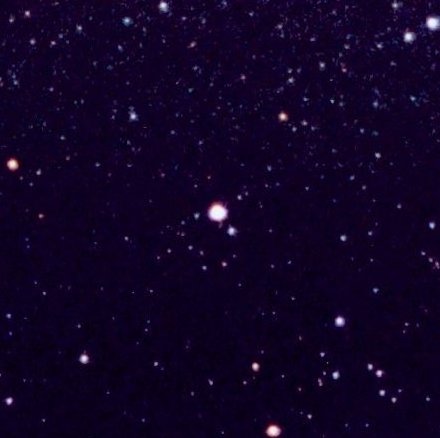 Second magnitude Polaris, Alpha Ursae Minoris, of
Ursa Minor (at the end of the handle of the Little Dipper) is
smack in the middle of the picture, which is 6.0 degrees across.
Yildun, Delta UMi, is the bright star at upper right. Lambda UMi
(a red giant, note the color), lies in between them. The star
immediately down and to the right of Polaris is HR 286, while 24
UMi is just down and to the left of Yildun. 2 UMi, which is
actually in Cepheus, is the bright star at the lower edge to the
right. OV Cephei, actually in Cepheus proper, is at the far left
edge just above center. HR 1107 (Cepheus) is the brighter of the
two stars down tward the lower left corner. HR 306 and HR 8938 are
the two brighter stars to the right of HR 1107, while HR 4686 lies
near the top edge just to the left of center. The ragged circle of
faint stars down and to the left of Polaris is called the
"Engagement Ring," with of course Polaris as its shining stone.
The North Celestial Pole (for the year 2000) is just to the left of
the center of the line between Polaris and Lambda. Polaris is
right at mid-second magnitude. Lambda (at magnitude 6.4) and HR 286
(6.5) are near the limit of naked-eye vision. The faintest stars
in the picture are 10th magnitude.
Second magnitude Polaris, Alpha Ursae Minoris, of
Ursa Minor (at the end of the handle of the Little Dipper) is
smack in the middle of the picture, which is 6.0 degrees across.
Yildun, Delta UMi, is the bright star at upper right. Lambda UMi
(a red giant, note the color), lies in between them. The star
immediately down and to the right of Polaris is HR 286, while 24
UMi is just down and to the left of Yildun. 2 UMi, which is
actually in Cepheus, is the bright star at the lower edge to the
right. OV Cephei, actually in Cepheus proper, is at the far left
edge just above center. HR 1107 (Cepheus) is the brighter of the
two stars down tward the lower left corner. HR 306 and HR 8938 are
the two brighter stars to the right of HR 1107, while HR 4686 lies
near the top edge just to the left of center. The ragged circle of
faint stars down and to the left of Polaris is called the
"Engagement Ring," with of course Polaris as its shining stone.
The North Celestial Pole (for the year 2000) is just to the left of
the center of the line between Polaris and Lambda. Polaris is
right at mid-second magnitude. Lambda (at magnitude 6.4) and HR 286
(6.5) are near the limit of naked-eye vision. The faintest stars
in the picture are 10th magnitude.
|
 Second magnitude Polaris, Alpha Ursae Minoris, of
Ursa Minor (at the end of the handle of the Little Dipper) is
smack in the middle of the picture, which is 6.0 degrees across.
Yildun, Delta UMi, is the bright star at upper right. Lambda UMi
(a red giant, note the color), lies in between them. The star
immediately down and to the right of Polaris is HR 286, while 24
UMi is just down and to the left of Yildun. 2 UMi, which is
actually in Cepheus, is the bright star at the lower edge to the
right. OV Cephei, actually in Cepheus proper, is at the far left
edge just above center. HR 1107 (Cepheus) is the brighter of the
two stars down tward the lower left corner. HR 306 and HR 8938 are
the two brighter stars to the right of HR 1107, while HR 4686 lies
near the top edge just to the left of center. The ragged circle of
faint stars down and to the left of Polaris is called the
"Engagement Ring," with of course Polaris as its shining stone.
The North Celestial Pole (for the year 2000) is just to the left of
the center of the line between Polaris and Lambda. Polaris is
right at mid-second magnitude. Lambda (at magnitude 6.4) and HR 286
(6.5) are near the limit of naked-eye vision. The faintest stars
in the picture are 10th magnitude.
Second magnitude Polaris, Alpha Ursae Minoris, of
Ursa Minor (at the end of the handle of the Little Dipper) is
smack in the middle of the picture, which is 6.0 degrees across.
Yildun, Delta UMi, is the bright star at upper right. Lambda UMi
(a red giant, note the color), lies in between them. The star
immediately down and to the right of Polaris is HR 286, while 24
UMi is just down and to the left of Yildun. 2 UMi, which is
actually in Cepheus, is the bright star at the lower edge to the
right. OV Cephei, actually in Cepheus proper, is at the far left
edge just above center. HR 1107 (Cepheus) is the brighter of the
two stars down tward the lower left corner. HR 306 and HR 8938 are
the two brighter stars to the right of HR 1107, while HR 4686 lies
near the top edge just to the left of center. The ragged circle of
faint stars down and to the left of Polaris is called the
"Engagement Ring," with of course Polaris as its shining stone.
The North Celestial Pole (for the year 2000) is just to the left of
the center of the line between Polaris and Lambda. Polaris is
right at mid-second magnitude. Lambda (at magnitude 6.4) and HR 286
(6.5) are near the limit of naked-eye vision. The faintest stars
in the picture are 10th magnitude.
